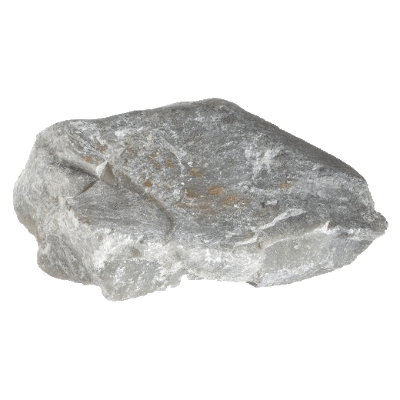Composition of talc usually stays close to this generalized formula, some substitution occurs. Small amounts of Al or Ti can substitute for Si; small amounts of Fe, Mn and Al can substitute for Mg; and, very small amounts of Ca can substitute for Mg.
When large amounts of Fe substitute for Mg the mineral is known as minnesotaite. When large amounts of Al substitute for Mg the mineral is known as pyrophyllite.
Talc is usually green, white, gray, brown or colorless. It is a translucent mineral with a pearly luster. It is the softest known mineral and is assigned a hardness of 1 on the Mohs Hardness scale.
Talc is a monoclinic mineral with a sheet structure similar to the micas. Talc has perfect cleavage that follows planes between the weakly bonded sheets. These sheets are held together only by van der Waals bonds which allows them to slip past one another easily.
Uses of Talc
Most people use products made from talc every day, however, they don't realize that talc is in the product or the special role that it plays.
Talc in Plastics
In 2011, about 26% of the talc consumed in the United States was used in the manufacturing of plastics. It is mainly used as a filler. The platy shape of talc particles can increase the stiffness of products such as polypropylene, vinyl, polyethylene, nylon and polyester. It can also increase the heat resistance of these products and reduce shrinkage..
Talc in Ceramics
In the United States in 2011, about 17% of the talc consumed was used in the manufacturing of ceramics products such as bathroom fixtures, ceramic tile, pottery and dinnerware.
Talc in Paint
Most paints are suspensions of mineral particles in a liquid. The liquid portion of the paint facilitates application but after the liquid evaporates the mineral particles remain on the wall. Talc is used as an extender and filler in paints. The platy shape of talc particles improves the suspension of solids in the can and helps the liquid paint adhere to a wall without sagging.
Powdered talc is a very bright white color. This makes talc an excellent filler in paint because it simultaneously serves to whiten and brighten the paint. Talc's low hardness is valued because it causes less abrasion damage on spray nozzles and other equipment when paint is applied. In 2011, about 16% of the talc consumed in the United States was used to make paint.
Talc in Paper
Most papers are made from a pulp of organic fibers. This pulp is made from wood, rags and other organic materials. Finely-ground mineral matter is added to the pulp to serve as a filler. When the pulp is rolled into thin sheets the mineral matter fills spaces between the pulp fibers, resulting in a paper with a much smoother writing surface. Talc as a mineral fillers can improve the opacity, brightness and whiteness of the paper. Talc also can also improve the paper's ability to absorb ink. In 2011, the paper industry consumed about 16% of the talc used in the United States.



Write Comment